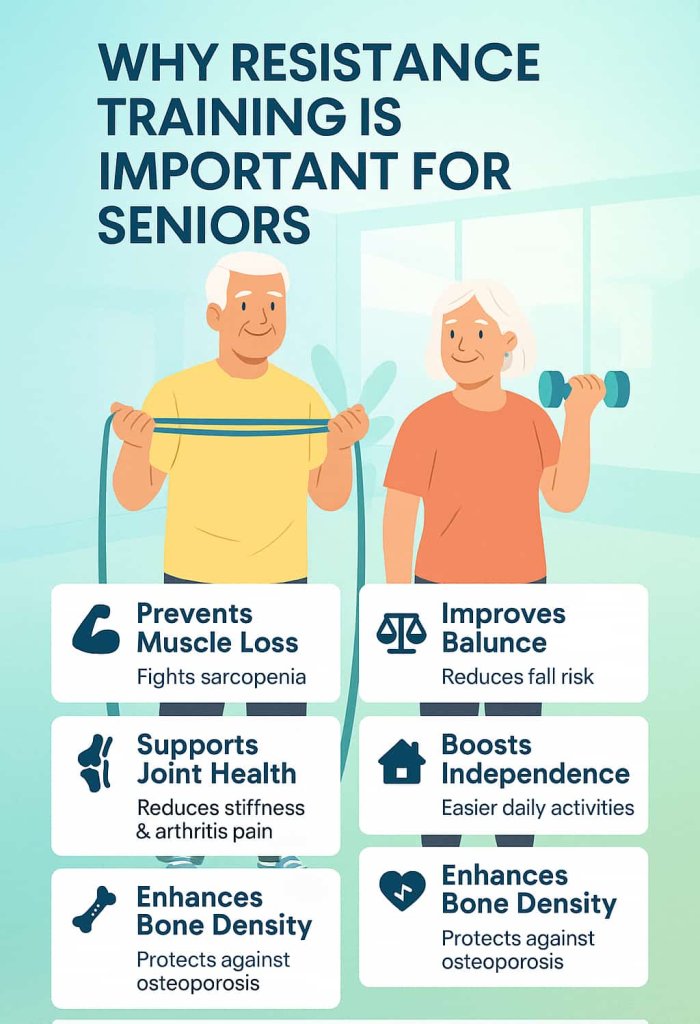Yes — seniors can safely build strength after 60 with resistance training, and it’s one of the best ways to stay strong, mobile, and independent.
After age 60, muscle mass naturally declines (sarcopenia), which can lead to weakness, frailty, and higher fall risk. Resistance training slows or reverses this decline by improving strength, balance, bone density, and daily function.

With simple exercises like squats, rows, and shoulder presses, older adults can boost mobility, reduce stiffness, and support independence. The key is to start light, focus on form, and progress gradually.
👉 According to the National Institute on Aging (2024), strength training not only builds muscle but also helps manage arthritis, diabetes, heart disease, and osteoporosis (NIA.gov).
This guide covers the 12 best resistance training exercises for seniors after 60, along with safety tips, modifications, and expert-backed programming advice.
Why Resistance Training Is Important for Seniors

- Prevents muscle loss (sarcopenia): Adults over 60 lose 3–8% of muscle mass per decade without training.
- Improves balance & reduces fall risk: Stronger legs and core muscles stabilize walking and standing.
- Supports joint health: Strength training reduces stiffness, arthritis pain, and improves mobility.
- Boosts daily independence: Easier stair climbing, lifting groceries, and household chores.
- Enhances bone density: Weight-bearing resistance training helps fight osteoporosis.
- Heart & metabolic health: Improves blood sugar control, blood pressure, and cholesterol.
👉 A 2024 BMJ Open Sport & Exercise Medicine study found that older adults who performed heavy resistance training (70–85% of 1RM) three times per week preserved leg strength over four years.
12 Best Resistance Training Exercises for Seniors
Below are the most effective and safe resistance training exercises for seniors. Each can be done with bodyweight, resistance bands, or light weights — depending on your comfort and ability.
1. Sit-to-Stand (Chair Squat)
- Muscles worked: Quadriceps, glutes, hamstrings
- Why it helps: Builds essential leg strength for standing, walking, and climbing stairs.
How to do it:
- Sit on a sturdy chair with feet flat, hip-width apart.
- Cross arms over chest or place hands lightly on chair for support.
- Lean forward slightly, press through heels, and stand tall.
- Slowly lower back down with control.
Trainer tip: Start with partial stands if needed. Progress to bodyweight squats without a chair.
Common mistake: Collapsing knees inward. Keep knees tracking over toes.
2. Deadlift (Hip Hinge Variation)
- Muscles worked: Glutes, hamstrings, lower back, core
- Why it helps: Strengthens posterior chain and improves safe lifting mechanics.
How to do it:
- Stand tall with feet hip-width apart, holding light dumbbells or a kettlebell.
- Hinge at the hips (not lower back), pushing hips back.
- Lower weights to knee height with flat back.
- Drive through heels to return to standing.
Trainer tip: Practice with a dowel or no weight before adding load.
Common mistake: Rounding the back. Keep spine neutral, chest open.
3. Chest Press (Dumbbell or Machine)
- Muscles worked: Chest, shoulders, triceps
- Why it helps: Builds pushing strength for tasks like opening doors or pushing carts.
How to do it:
- Sit on a bench or machine, or lie on a flat bench with dumbbells.
- Hold weights at chest level, elbows bent.
- Press weights upward until arms are straight.
- Lower slowly with control.
Trainer tip: Use resistance bands if dumbbells feel heavy.
Common mistake: Arching lower back. Keep core engaged.
4. Seated or Band Row
- Muscles worked: Upper back, lats, biceps
- Why it helps: Improves posture and pulling strength, countering rounded shoulders.
How to do it:
- Sit tall, loop band around a sturdy anchor.
- Hold band handles, arms extended.
- Pull elbows back toward torso, squeezing shoulder blades.
- Slowly return to start.
Trainer tip: Imagine “pinching a pencil” between your shoulder blades.
Common mistake: Shrugging shoulders. Keep them relaxed.
5. Shoulder Press
- Muscles worked: Shoulders, triceps
- Why it helps: Improves overhead strength for reaching into cupboards.
How to do it:
- Sit or stand with dumbbells at shoulder height.
- Press weights overhead until arms are fully extended.
- Lower slowly.
Trainer tip: Start with light weights or press one arm at a time.
Common mistake: Arching back. Keep core engaged.
6. Lat Pulldown (or Band Pulldown)
- Muscles worked: Lats, biceps, upper back
- Why it helps: Strengthens back muscles, improving posture and shoulder stability.
How to do it:
- Sit at pulldown machine or hold a resistance band overhead.
- Pull bar/band down to chest level.
- Release slowly.
Trainer tip: Keep chest lifted, don’t lean back excessively.
Common mistake: Using momentum. Pull smoothly.
7. Calf Raises
- Muscles worked: Calves, ankles
- Why it helps: Improves balance, walking, and ankle stability.
How to do it:
- Stand near a wall or chair for support.
- Rise onto toes, hold for 2–3 seconds.
- Lower back down slowly.
Trainer tip: Progress to single-leg raises for more challenge.
Common mistake: Bouncing. Move with control.
8. Hip Abduction (Side Leg Raises)
- Muscles worked: Gluteus medius, outer thighs
- Why it helps: Enhances side-to-side stability, reducing fall risk.
How to do it:
- Stand tall, holding a chair for balance.
- Lift one leg out to the side.
- Lower slowly. Switch sides.
Trainer tip: Add ankle weights or resistance band for more resistance.
Common mistake: Leaning sideways. Keep torso upright.
9. Leg Extensions / Leg Curls (Machine or Band)
- Muscles worked: Quadriceps (extension), hamstrings (curl)
- Why it helps: Strengthens muscles that support and protect the knees.
How to do it:
- Extensions: Sit on leg machine or use band under foot. Extend knee straight, then return slowly.
- Curls: Lie face down on machine or loop band around ankles. Curl heel toward glutes, return slowly.
Trainer tip: Stop just short of locking the knees.
Common mistake: Jerking movements. Keep it controlled.
10. Bicep Curls
- Muscles worked: Biceps
- Why it helps: Improves grip, lifting ability, and daily carrying tasks.
How to do it:
- Hold dumbbells or resistance band at sides.
- Curl weights toward shoulders, palms up.
- Lower slowly.
Trainer tip: Keep elbows tucked close to your body.
Common mistake: Swinging arms. Use steady motion.
11. Triceps Extensions
- Muscles worked: Triceps
- Why it helps: Strengthens arms for pushing up from chairs or supporting body weight.
How to do it:
- Hold dumbbell overhead, arm straight.
- Bend elbow, lowering weight behind head.
- Extend back up.
Trainer tip: Use resistance bands for pushdowns if overhead motion is uncomfortable.
Common mistake: Flaring elbows. Keep elbows close to head.
12. Glute Bridge
- Muscles worked: Glutes, hamstrings, core
- Why it helps: Strengthens hips and lower back, supporting mobility and posture.
How to do it:
- Lie on back, knees bent, feet flat on floor.
- Push through heels to lift hips until body is straight from shoulders to knees.
- Hold 2–3 seconds, lower slowly.
Trainer tip: Place a small cushion or ball between knees to engage inner thighs.
Common mistake: Overarching lower back. Keep ribs down.
Resistance Training Tips for Seniors
- Start light: Begin with bodyweight or resistance bands.
- Frequency: 2–3 sessions per week, 20–40 minutes each.
- Sets & reps: 2–3 sets of 8–12 reps per exercise.
- Progression: Increase resistance every 2–3 weeks as strength improves.
- Rest: 1–2 minutes between sets; 48 hours before training same muscle group.
- Form first: Quality > quantity.
👉 The NSCA Position Statement (2019) confirms that older adults can safely lift moderate-to-heavy loads when progression and form are respected.
Safety Tips for Seniors Doing Resistance Training
- Warm up with 5–10 minutes of walking or gentle marching.
- Start with light weights or resistance bands.
- Focus on slow, controlled movements — not speed.
- Breathe naturally: exhale on exertion, inhale on return.
- Use a sturdy chair, wall, or rail for balance when needed.
- Stop if you feel dizziness, sharp pain, or chest discomfort.
- Consult a doctor before starting if you have heart disease, arthritis, or joint replacements.
Who Should Avoid or Modify Resistance Training?
- Those with uncontrolled hypertension, unstable heart conditions, or recent surgeries — consult your doctor first.
- If you have joint replacements, severe arthritis, or osteoporosis, stick to low-impact movements with professional guidance.
- Always warm up 5–10 minutes before training and stop if you feel dizziness, chest pain, or sharp joint pain.
FAQs About Resistance Training for Seniors
1. Is resistance training safe after 60?
Yes. With proper progression, it’s safe and highly beneficial. Always consult your doctor if you have chronic conditions.
2. How heavy should seniors lift?
Start light (bands, 2–5 lb dumbbells) and progress. Many older adults safely train at 60–80% of their max with guidance.
3. Can resistance training improve bone density?
Yes. Weight-bearing exercises (squats, presses) help fight osteoporosis.
4. How often should seniors do resistance training?
At least 2–3 times weekly, with rest days in between.
5. What equipment is best for seniors?
Resistance bands, light dumbbells, cable machines, and bodyweight exercises.
6. Can resistance training help with arthritis?
Yes. It reduces joint stiffness and strengthens surrounding muscles, easing pain.
7. Should seniors combine resistance training with cardio?
Yes. A mix of both gives the best benefits for heart health, mobility, and strength.
Conclusion
Resistance training after 60 is not only safe — it’s one of the most powerful ways to stay strong, independent, and pain-free as you age. With just 2–3 sessions a week, you can build muscle, protect your joints, reduce fall risk, and keep doing the activities you love.
👉 Start with the 12 exercises above, focus on good form, and progress gradually. For personalized guidance, consider working with a trainer or physical therapist.
Stay strong, stay independent, and make resistance training a lifelong habit.
